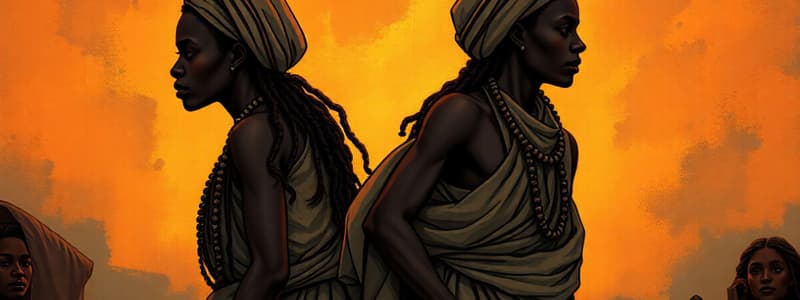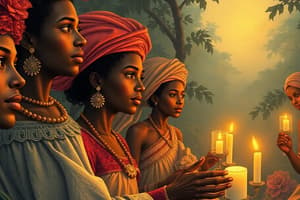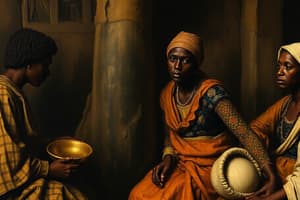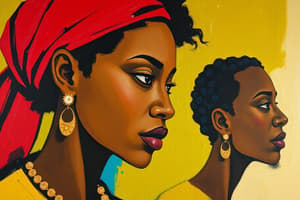Podcast
Questions and Answers
Based on the content, what was a significant factor in determining who received the monetary value of a deceased enslaved person's body?
Based on the content, what was a significant factor in determining who received the monetary value of a deceased enslaved person's body?
- The enslaver's discretion, based on their assessment of the enslaved person's loyalty and service.
- The deceased's will and testament, outlining their wishes for their remains and assets.
- The deceased's family structure and social standing within the enslaved community.
- Court rulings, which considered the cause of death and other factors to settle financial claims. (correct)
What does the content suggest about the monetary valuation of enslaved people?
What does the content suggest about the monetary valuation of enslaved people?
- The monetary valuation of enslaved people was a straightforward process, with fixed prices based on age, gender, and skills.
- The monetary value of enslaved people was consistently low, reflecting their lack of legal rights and social standing.
- The monetary valuation of enslaved people extended from preconception to postmortem, affecting various aspects of their existence. (correct)
- The monetary valuation of enslaved people only applied to adults, as children and the elderly were not considered valuable assets.
How did the commodification of enslaved people influence medical practices during the time period discussed?
How did the commodification of enslaved people influence medical practices during the time period discussed?
- Medical schools refused to use enslaved people's bodies for dissection due to ethical concerns.
- Enslaved people had the right to refuse medical treatment or dissection, ensuring their bodily autonomy.
- Physicians collaborated with enslavers to acquire cadavers for anatomical study, contributing to the domestic cadaver trade. (correct)
- Medical practices were completely separate from the system of enslavement, with no interaction between enslavers and physicians.
How did enslaved people express resistance to their commodification, according to information presented?
How did enslaved people express resistance to their commodification, according to information presented?
What does the content imply about the relationship between enslavers, physicians, and enslaved people?
What does the content imply about the relationship between enslavers, physicians, and enslaved people?
What is the central theme explored in the provided content regarding enslaved people?
What is the central theme explored in the provided content regarding enslaved people?
Jourden H. Banks's narrative is presented in the content to primarily illustrate which of the following?
Jourden H. Banks's narrative is presented in the content to primarily illustrate which of the following?
What does the content suggest about the study of enslaved people's value, differentiating it from other studies?
What does the content suggest about the study of enslaved people's value, differentiating it from other studies?
Based on the content, what was a significant factor that contributed to Jourden Banks's early understanding of the difference between himself and his enslaver's son?
Based on the content, what was a significant factor that contributed to Jourden Banks's early understanding of the difference between himself and his enslaver's son?
What can be inferred from the price ranges provided ($0-$5,771 appraisal, $0.14-$3,228 sale) regarding enslaved people?
What can be inferred from the price ranges provided ($0-$5,771 appraisal, $0.14-$3,228 sale) regarding enslaved people?
How does the organization of the chapters of the book mentioned in the content enhance its exploration of the topic?
How does the organization of the chapters of the book mentioned in the content enhance its exploration of the topic?
What do the quotes from Benjamin Banneker and The Christian Recorder at the beginning of the content primarily serve to highlight?
What do the quotes from Benjamin Banneker and The Christian Recorder at the beginning of the content primarily serve to highlight?
Based on the provided information, what assumption can be made about prevailing contemporary attitudes regarding enslaved people at the time?
Based on the provided information, what assumption can be made about prevailing contemporary attitudes regarding enslaved people at the time?
Flashcards
Life Cycle of Human Property
Life Cycle of Human Property
Being considered property from conception to after death.
Monetized Value of Death
Monetized Value of Death
The practice of assigning a monetary value to enslaved people.
Domestic Cadaver Trade
Domestic Cadaver Trade
The buying and selling of dead bodies to medical schools for dissection.
Commodification Response
Commodification Response
Signup and view all the flashcards
Commodification Impact
Commodification Impact
Signup and view all the flashcards
Appraisal Price Range
Appraisal Price Range
Signup and view all the flashcards
Sale Price Range
Sale Price Range
Signup and view all the flashcards
Jourden H. Banks
Jourden H. Banks
Signup and view all the flashcards
Book Focus
Book Focus
Signup and view all the flashcards
Life Cycle Valuation
Life Cycle Valuation
Signup and view all the flashcards
Value
Value
Signup and view all the flashcards
Value Perception
Value Perception
Signup and view all the flashcards
Book Structure
Book Structure
Signup and view all the flashcards
Study Notes
- Jourden H. Banks, born into slavery, sold three times, escaped twice, and eventually attained freedom.
Banks's Early Life and Epiphanies
- Early life seemed relatively pleasant initially, but changed as he matured.
- Banks realized his difference from his enslaver's son, Alexander, after Alexander started beating him.
- Banks fought back due to his father's warning about enduring beatings.
- Banks kept track of the whippings he "owed" Alex and retaliated in kind.
- Banks understood his "soul value" and separated himself from his enslaver early in life.
- Banks experienced an epiphany when he realized that Alex went to school, while he was sent to scare crows in the fields.
Enslaved People and Death
- Wilma King refers to this realization as "the quantum leap" into the world of work.
- Enslaved youth and young adults learned about their place in the world as they aged.
- Banks's understanding of enslavement was solidified by the sale of his sisters, the severe beating of his mother, and his enslaver's death.
- Enslaved adults knew that an enslaver's death often meant the breaking up of families.
- Banks was put on the auction block in the summer of 1857 and tried to liberate himself by running away.
The Auction Block
- Banks demonstrated defiance during interviews with potential buyers by not revealing information about his health and skills.
- Banks was eventually purchased for $1,200.
Commodification
- Explores how enslaved people recalled and responded to their monetary value throughout life.
- Examines enslaved and free blacks' values, as well as individuals with a vested interest in their fiscal vitality during their lives, at their death, and even after death.
- Intimate ties between enslavers, physicians, and human property show how commodification touched all aspects of enslaved people's lives.
- Addresses an intellectual history of enslaved people's thoughts, expressions, feelings, and reactions to their own commodification.
Book Structure
- Each chapter represents a window into enslaved people's awareness of their monetary value.
- Places them in conversation with enslavers' accounting of their bodies from birth to death.
- Focuses on the life cycle of the enslaved person's body rather than a chronological structure.
- Examines the spiritual and financial value of human commodities before and at birth, and even after death, which forces a reconsideration of the life cycle of human property.
The Life Cycle of Human Property
- Explores the meaning of having a projected or real price from preconception to postmortem.
- Even unborn children of expectant mothers were marked with a monetary value.
- Addresses who would receive money for a body after an enslaved person died.
- Financial value of enslaved bodies was sometimes contested in court, depending on the cause of death.
Exploitation of the Dead
- Death became a monetized value that accrued interest until cases were settled.
- Some dead bodies were cultivated as cadavers and sold to medical schools for anatomy courses.
- Addresses enslaved people's ideas about the afterlife and their preferences for burial rituals, even when doctors wanted to harvest their bodies for dissection.
Experiences as a Fugitive
- Banks was jailed in Smithland, Kentucky, in October 1857 for seven months and two days, in a jail that was more like a place of punishment than a place of detention.
- Jailers tried to extract answers from prisoners.
- Banks found it ironic that the jailers believed that the "worse we were treated the more likely we should be to tell where we came from."
- Banks and fellow captives shared a code of secrecy and prison life was "a trap."
Enslaved as Currency
- The author analyzes slave value as literal currency and worth, with a constant connection to wealth and resources
- Physicians treated the sick, enslavers responded to notices, and two whites came when convicted of murder and other crimes.
- Banks encountered an emaciated man who shared his cell and was near death.
- The doctor who treated his sick cellmate learned that he suffered from tuberculosis and needed care and found out where he came from, as well as his enslaver's name.
- The doctor promised to purchase and care for him.
Valuation of the Enslaved
- The enslaver claimed his property and refused to sell a nearly dead man to a physician who was willing to pay a "price for his pound of flesh" above market value. The slave owner preferred to make an example of him, and asserting that dead or alive, he had use for his enslaved body
- Banks observed that the owners pursue the slaves who escape with a spirit of revenge.
- Enslaved people represented an exchangeable commodity in the eyes of traders, enslavers, and doctors.
- The financial value of human chattel touched every facet of their lives.
- Enslaved people had particular ideas about their value that differed greatly from their enslavers.
- Shifts the way we interpret slavery and adds to our understanding of social and cultural systems that continue to (de)value black life.
- This books incorporates the voices of those traded on the auction block along with the valuations of their captivity.
- Enslaved people speak back through their words and actions. They are inviting the reader to hear their stories, to see them as human beings.
- Explores a journey that hinges upon capitalism and commodification, as well as human emotions and expressions of love, loss, and grief.
- It is the story of human chattel and the duality of their position in life and death.
- Enslaved children announcement was found in form of records ledgers, bills or announcements
Value Metrics
- Monetary metrics of value were assigned to enslaved people to grade them vs personal assessment of worth
- People had special qualities that were graded and published through newspapers as the enslavers's perspective
- As commodities slaves were used in many subjective and reflexive contexts
- Slave's value was graded by its own personal spirit - an internal quality that defies monetization
- This signifies self worth of person, despite a weakening and negotiation to their condition
- Book aims to uncover living soul in the system
- "Flesh and Blood Values" means soul assessment
Death and Burial Rituals
- Unlike normal births death have slaves the opportunity towards redemption
- Some enslaved people were given obituaries if valued- and this provides insights to legacy, service and personality
- Multiple value sets encompass people/ property
- Slave value is also given by others like planters and doctors, and the sale price market
- Slave value also given at death at legal contests
- Once enslaved bodies die and are then used , they are given a ghost value
- They are transported / sold throughout the US at medical schools
- Legal disputes of hiring contracts where the slave also valued after life as deaths needs to be settled
- Enslaved people's history also present on dissection tables to prominent medical physicians
- Dead bodies are also subject to a coroner's inquest to find cause of death
- Limited publicity happens afte raslves die , few places will give coffins for slaves
- Slaves had limited access to rest, or their family
- Africans created an underground disposal system that used human bodies, later exhumed
- Blackely, Sappol, and Washington's research all contributed to black disposal / trafficking
- 1980 and 1990s remains found showing improper remains/ bodies given to slaves
- All led to create new studies to create slave lives, deaths, and the goal of the book is not to dispose like animal remains
- This aims at the idea of a world with death and liberation and valuing towards all souls for their value.
Studying That Suits You
Use AI to generate personalized quizzes and flashcards to suit your learning preferences.




